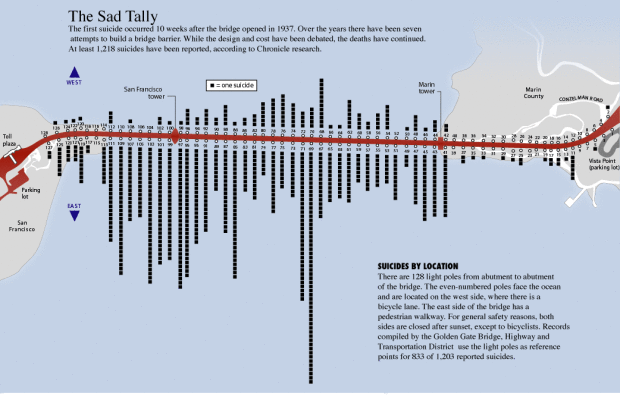This graphic from SF Gate is a good four years old, well before I knew what an infographic was, but just because it’s old doesn’t mean it’s not interesting. Here we see San Francisco’s Golden Gate Bridge and the “sad tally” of 1,218 known suicides by location. Each black square represents a person who has taken his or her life and 128 light poles are used as reference points.
The east side of the bridge, where most of the suicides occurred, has a pedestrian walkway. The first suicide was just 10 weeks after the bridge opened in 1937.
[Thanks, Justin]


 Visualize This: The FlowingData Guide to Design, Visualization, and Statistics (2nd Edition)
Visualize This: The FlowingData Guide to Design, Visualization, and Statistics (2nd Edition)

Interesting that so many are on the south side….
The east/west arrows confuses me. I also wonder if previous commenter isn’t confused too.
I would prefer a more traditional NORTH arrow. Since this is a top view, I tend to read it as I would read a map.
my best bet is that it was mainly intended for an SF audience who might be used to referring to the east and west side of the bridge. just a hunch
see also Bureau of Inverse Technology’s Suicide Box:
http://www.bureauit.org/sbox/
Both sides have pedestrian walkways http://sanfrancisco.about.com/od/sfattractionslandmarks/ss/goldengatebridg_3.htm
The east side faces the city. The east side is also easier to get to. The south end of the bridge on the east side is the main entrance for tourists and where buses and cabs drop people off.
The middle of the span is the best view of the city.
I believe Nathan is right. East / West makes more sense if you live here (west facing the ocean and east facing the city). It lends unsubstantiated credence about getting a view of the city has one jumps from the bridge, but technically that side of the bridge is just easier to get to from cab or bus. I would almost bet money that those jumping from the west side of the bridge are mostly locals (and it is almost ENTIRELY locals that jump from the Bay Bridge). I suspect the west side is probably monitored with slightly less diligence than the east side. The halfway point might represent the “breaking point” too for those wandering out on the bridge. A sort of “Well, once I get there I’m going it or I’m not.” kind of thinking.
Junk Charts had a post about this graphic approx. 4 years ago: http://junkcharts.typepad.com/junk_charts/2005/11/the_sad_tally.html
Great courage to post it again!
After I blogged it on infosthetics.com, this post somehow ended up quite high in Google search results with specific search terms, and acquired +106 comments, of which some quite terrifying…
that’s gotta be the weirdest thread ever on infosthetics
Pingback: Suicides by Location on the Golden Gate Bridge | FlowingData | India Updates
http://www.youtube.com/watch?v=8PnqVocIZLY&feature=related
(WARNING: This cannot be unseen))
I saw this movie when it first came out. Being a long time resident of SF makes it more difficult because eventually you know someone that has made “the jump”.
Last year a friend of mine jumped 3 weeks after his mother passed away. He had called a few friends the night before to see how they were and to tell them he loved them, then disappeared until found after the fact days later. So sad, I hope it eased his pain like he intended. Depression is not something that is untreatable. Things are certainly out of our control but our mind can go it’s own what sometimes and that’s when a professional should be brought into the mix for a better more clear perspective. Be kind to yourself. XOXO
The peninsula hooks around and that’s the way this graph is laid out. What your eye sees as being south, is in fact east looking back towards the city. I know a couple posters here tried to explain it but I was even confused by their explanations.
Pingback: Semantic shite & Data Analytics « linknews